Cultivated on the Suffolk coast for centuries, artisanal oysters are once again tickling the tastebuds. John Worrall reports
Down on the mid-Suffolk coast, the river Alde, which becomes the Ore, runs inside Orford Ness, the longest shingle spit in Europe, which deflects the river southwards from Aldeburgh for nearly 10 miles before allowing it to issue at the gloriously unearthly Shingle Street.

Bill Pinney checks a batch of juvenile oysters…
Three-quarters of the way down that deflection, just south of the village of Orford (once a major medieval port), the Ore is joined by Butley creek, which snakes inland for three or four miles to end in a reed bed close to the village of the same name.
The creek is a backwater in the true sense, approached by no road except a lane that glances the reeds, although a summertime weekend rowing boat ferry connects footpaths on its lower reach. The ferry possibly started as far back as the ninth century when monks first arrived at Butley, although the Augustinian priory, of which only a gatehouse and arch remain, wasn’t founded until 1171. The ferry closed just after the First World War, but was reopened in 1993, since when walkers and cyclists have again been rowed across by a ferryman wearing a land worker’s traditional black floppy hat in the style of a crash-landed pancake.

… which will be ready to harvest inside a year.
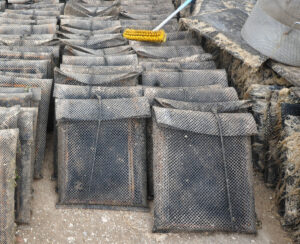
When seed oysters arrive from the hatchery, they go into bags with a fine mesh…
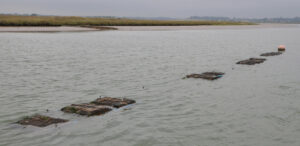
… which are put into bread trays and attached to floated ropes in the creek.
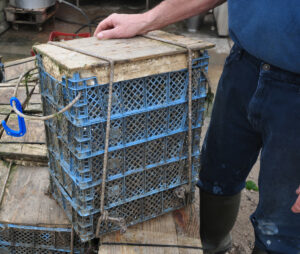
As they get bigger, they go into mushroom trays in stacks of five, each with their own polystyrene raft…
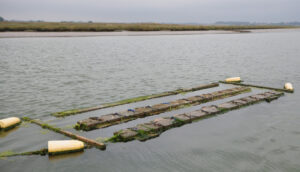
… which are also attached to ropes in the creek.

They need constant monitoring, which means rowing out…
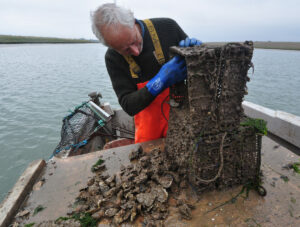
… to check growth and general wellbeing. These larger juveniles look big enough to be put loose on the creek bed.
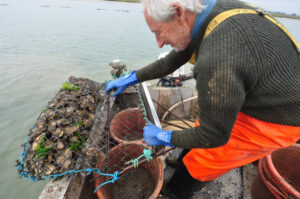
A couple of minutes fills the dredge with market-sized oysters.
Just above the ferry is an oyster farm, and Butley oyster farming probably goes back as far as the ferry – those monks would surely have been partial. Either way, Butley oysters were famous in Victorian times. But then, like the ferry, they suffered a 20th-century hiatus when the last operator, Mac Fisheries, abandoned the beds in 1925.
However, the oysters’ pause was shorter, because just after the Second World War, Richard Pinney, who’d had enough of London and was looking for a change of direction, came upon the derelict beds, which were attended by an equally derelict cottage. Shrugging off warnings about oysters being a great way to lose money, he decided to try a revival.
Historically, oysters on this coast had been the native flat oyster Ostrea edulis, but it’s a slow grower, taking four or five years to reach maturity, and a quicker-growing variety, Virginia Blue Point, had been brought into the Butley mix, which was what Richard found when he started. He added some Portuguese rock oysters, which grew well and sold well to pubs and restaurants, and within a few years, he’d built up a big stock in the creek. Things were looking good.
But then came the 1962-63 winter, which killed the lot. And within a few years, the industry generally – though not Butley creek – began to suffer a much greater incidence of Bonamia ostreae, a parasite that kills the native edulis as it reaches maturity. That talk of losing money suddenly rang true.
But cultivation was evolving worldwide, and in the late 1960s, UK government scientists brought in some Japanese rock oysters, Crassostrea gigas, which, crucially, were unaffected by Bonamia. By then, Richard’s son, Bill, who now runs the show, was working with his dad.
“They brought us some samples,” said Bill, “and they were quite small, and we thought, ‘What do we do with these?’ So we chucked them on the bottom of the creek and forgot about them. Came back a few months later and looked, and they’d grown into lovely oysters, and very quickly. Straightaway we were pretty much sold on them. And the government didn’t need to import any more after that first batch. They bred them in hatcheries, and that happened all across Europe, and they became the rock oyster of choice.
“They are quite hardy – they can put up with hot and cold – and they only take a couple of years to grow. And they can tolerate occasional low salinity. Heavy rain and run-off from surrounding farmland can drop the salinity in this creek quite dramatically, and gigas can cope with that, but natives can’t.”
And then in the 1980s and 1990s came a further advance with the development of the triploid oyster, when US researchers devised a way of mechanically manipulating the oysters’ chromosome structure. Natural oysters, like most animals, are diploid: each of their cells contains two sets of chromosomes, one from each parent – although plants mostly have more. Inserting an extra chromosome into an oyster cell breeds a triploid, which is usually infertile and, because it doesn’t waste energy in spawning and recovering, grows bigger and faster. More importantly, triploids are fat and marketable all year round, whereas in the summer months, diploids tend to be less savoury when they are spawning.
Before all that was happening, back in the 1970s Richard and Bill had a go at hatching oysters themselves.
“We went through the whole fascinating process,” said Bill. “Under the microscope, you can see the little eggs, and within 20 minutes of being fertilised, you can see them swimming – tiny eggs with eyelashes that they use to swim with. They then become a free-swimming larvae for 15 to 20 days, until they are ready to settle, and all the time you are feeding them very small algae.”
It is fascinating – but also time-consuming. So these days, Bill buys juvenile oysters, about 10mm long, from disease-free hatcheries, “Although Bonamia doesn’t affect gigas, herpes does. We haven’t got either here, and so we make sure we buy from a clean source.
“We bring in both triploids and diploids to spread the maturing rate of each batch. The main point of having triploids is to have oysters in great condition when the diploids are in the spawning season.”
Delivered in late summer, and therefore having the winter to harden up and acclimatise before growth restarts in the spring, they are first put into fine mesh bags, which are held in bread trays attached to floated ropes in the creek – and there they need constant monitoring, because the smallest meshes for the early stages are easily blocked by mud.
Then, as they grow – and growth rates vary within batches of both diploids and triploids – the oysters are taken out and sieved. The larger ones are put into bags with a bigger mesh, and the smaller ones stay where they are – a process which is repeated every few days early on, but then lengthens to intervals of a month or so. In the later stages, they are moved into mushroom trays in stacks of five (bread trays, mushroom trays – this is nothing if not an artisanal fishery). Each stack is suspended below its own polystyrene raft, attached to floated ropes.
And then, when the oysters have reached 15-20g, roughly a fifth of their final weight, they are spread loose on the creek bed.
“We take them out on the boat in baskets, which are emptied slowly over the side, with the boat circling so that the propeller wash spreads them. We rotate the parts of the creek where we do that, so that oysters of roughly the same size are in roughly the same place. It’s all a question of handling and quality control.
“And then, when we dredge them, we pick out those of market size, and put the rest back. It’s a continuous rolling process, but mostly, over the course of a year after their arrival from the hatchery, they have grown into a lovely hard oyster with a really good full meat.
“One advantage of not putting them onto the creek bed until they are part-grown is that they develop into the right shape – whereas in the wild, they settle at a much earlier stage and attach to something and grow round it, sometimes into a bad shape that makes them difficult to open.”
Landed oysters then go through the standard 42-hour shellfish depuration process, sitting in circulating clean, ultraviolet-treated water to purge any possible biological contaminants, along with mud and sand. They are then ready to blanket consumers’ tastebuds with their salty tang.
Early in his time at Butley, Richard converted an old outbuilding into a smokehouse, because he had been catching a few sea trout downriver and, for want of a better idea, smoked a few. The results were good, and he started buying in salmon to smoke, and that continues today, with other varieties of fish and a few oysters also getting the oak-smoked treatment.
The business is still family-run, these days by Bill and his wife Janet and the next generation, Jodie and George, but has diversified over the years. By the end of the 1960s, they had a restaurant in Orford, now the Butley Orford Oysterage on Market Hill. They also have two U10s, Jolene LT 1020 and Southern Cross LT 1032, which work the adjacent part of the southern North Sea, potting, netting and lining – at least as far as the pool quota allows, which isn’t very far these days. And there isn’t much sole anyway at the moment, after decimation by Dutch pulse trawlers.
The Pinneys also have a shop next to Orford Quay, a place much visited by holiday-makers, which sells everything that the boats, smokehouse and oyster beds produce, along with some delectable added-value products using some of those raw materials.
And even Covid-19 hasn’t stopped the show. While it did halt the shop and restaurant early on, although both are very much now open and thriving again, mail-order oysters – a dozen per iced pack delivered by courier (oyster knife supplied on request) – have become a major number.
There’s not much chance of those oyster beds falling derelict again for a while.
Find out more at: pinneysoforford.co.uk








